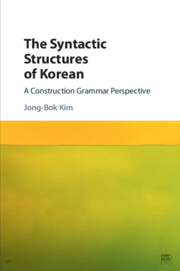Book contents
- Frontmatter
- Contents
- Acknowledgments
- Abbreviations
- 1 Theoretical foundations
- 2 Noun phrases
- 3 Case system
- 4 Auxiliary and complex predicate constructions
- 5 Gerund phrases and mixed categories
- 6 Verbal nouns and light verb constructions
- 7 Serial verb constructions
- 8 Negation and related phenomena
- 9 Coordination
- 10 Passive constructions
- 11 Wh-questions
- 12 Topic and focus constructions
- 13 Relative clause constructions
- 14 Honorification
- References
- Index
7 - Serial verb constructions
Published online by Cambridge University Press: 05 July 2016
- Frontmatter
- Contents
- Acknowledgments
- Abbreviations
- 1 Theoretical foundations
- 2 Noun phrases
- 3 Case system
- 4 Auxiliary and complex predicate constructions
- 5 Gerund phrases and mixed categories
- 6 Verbal nouns and light verb constructions
- 7 Serial verb constructions
- 8 Negation and related phenomena
- 9 Coordination
- 10 Passive constructions
- 11 Wh-questions
- 12 Topic and focus constructions
- 13 Relative clause constructions
- 14 Honorification
- References
- Index
Summary
The so-called serial verb construction (SVC) is a complex predicate structure consisting of two or more main verbs but denotes one single complex event with a series of connected subevents. This chapter discusses the grammatical properties of Korean SVCs and provides a lexicalist, construction-based HPSG analysis. In particular, we identify two typical types of SVCs in Korean as well as pseudo-SVCs, each of which has its own idiosyncrasies while sharing general properties with the other, related constructions. We also discuss the monoclausal properties of the SVCs and then offer a construction-based analysis that allows tight interactions between the lexicon and constructional constraints.
Serial verbs and general properties
The so-called serial verb constructions (SVC) allow more than one verb to occur without any specific coordination or subordination markings. Korean examples given in (1) are taken to belong to such constructions (Lee, S. 1993, Chung 1993, Chung and Kim 2008, among others):
(1) a. Mia-ka hakkyo-ey kel-e ka-ss-ta
Mia-NOM school-to walk-CONN go-PST-DECL
‘Mia went to school on foot.’
b. Mia-ka cwul-ul cap-a tangky-ess-ta
Mia-NOM rope-ACC hold-CONN pull-PST-DECL
‘Mia held a rope and pulled it.’
The serial verbs here denote actions that are closely connected to each other and can be considered to be part of the same complex event. For instance, (1a) represents an event of walking and its manner while (1b) denotes a complex event of holding and pulling a rope simultaneously.
The generation of such Korean SVCs, in which the first main verb is marked with the meaningless connective linker -a/e, is quite productive, as attested by the naturally occurring examples with the verb mek-ta ‘eat-DECL’:
(2) a. nanwu-e mek-ta ‘divide and eat’
divide-CONN eat-DECL
b. kkulh-ye mek-ta ‘boil and eat’
boil-CONN eat-DECL
c. mantul-e mek-ta ‘make and eat’
make-CONN eat-DECL
d. cap-a mek-ta ‘catch and eat’
catch-CONN eat-DECL
e. cip-e mek-ta ‘pick up and eat’
pick.up-CONN eat-DECL
f. ssip-e mek-ta ‘chew and eat’
chew-CONN eat-DECL
g. kwu-we mek-ta ‘roast and eat’
roast-CONN eat-DECL
h. ppal-a mek-ta ‘suck and eat’
suck-CONN eat-DECL
The examples here, extracted from the Sejong POS-tagged Corpus, show us that the activity verb mek- ‘eat’ can combine with various types of verbs and form the SVCs. Such productivity implies that the SVC is a grammatical process that the language employs.
- Type
- Chapter
- Information
- The Syntactic Structures of KoreanA Construction Grammar Perspective, pp. 144 - 168Publisher: Cambridge University PressPrint publication year: 2016



